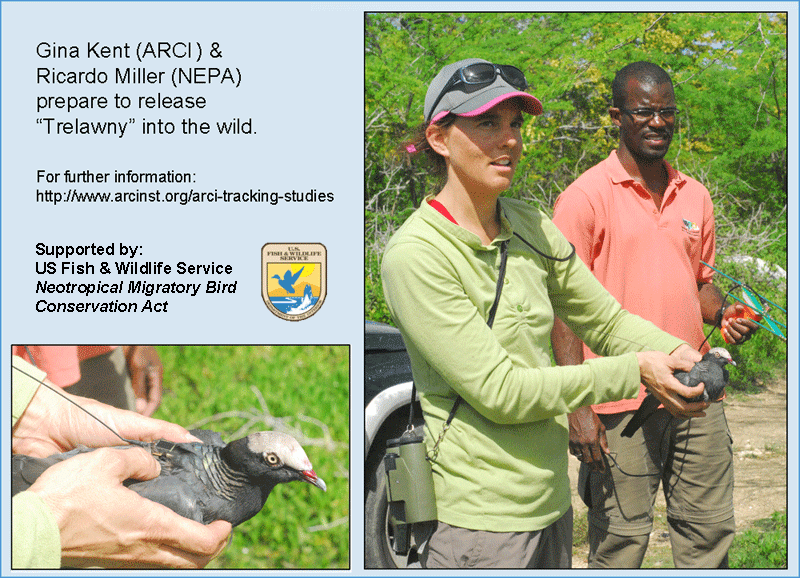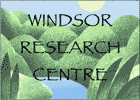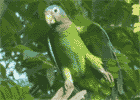Birds represent the most conspicuous wildlife on Jamaica and Cockpit Country is a critical sanctuary for them. The area supports populations of 67 resident breeding landbirds, including 28 of the island's 29 endemic species. At least 9 globally-threatened bird species and another 33 range-restricted species (i.e., birds endemic to the insular Caribbean) are found in Cockpit Country, making the area the highest-ranked Important Bird Area (IBA) on Jamaica (Levy and Koenig 2008).
The majority of Jamaica's resident birds occur across the island in suitable habitats and no species is restricted entirely to Cockpit Country. It is, however, the stronghold of the endemic Black-billed Parrot (Amazona agilis; IUCN Vulnerable) and is the main region on the island where both species of endemic Amazona parrots occur sympatrically in significant numbers. The mid-elevation wet limestone forest of Cockpit Country also is recognized as important habitat for the endemic Ring-tailed Pigeon (Patagioenas caribaea; Vulnerable), Crested Quail-Dove (Geotrygon versicolor; Vulnerable) and Blue Mountain Vireo (Vireo osburni; Near-Threatened). The Endangered Jamaican Blackbird (Nesopsar nigerrimus), locally known as "Wild Pine Sargeant", occurs in isolated pockets of Cockpit Country, most notably in areas of highest rainfall and humidity. The last probable records in Jamaica of the Golden Swallow (Tachycineta euchrysea), an endemic sub-species (Critically Endangered, Probably Extinct [IUCN 2014]), were in Cockpit Country in the early 1980s (Graves 2013).
Jamaica's endemic avifauna is associated most frequently with native habitat (Lack 1976). Over 60% of endemic species are rare or absent in open disturbed areas, and about 30% utilize well-developed forests during the nesting season (Draft National Biodiversity Strategy 1999). Several species that nest in mid- and late-successional forest, however, extend their range into the lowlands and secondary-growth habitats during the winter months (outside the breeding season). This pattern is pronounced in the resident Plain Pigeon (Columba inornata), Greater Antillean Elaenia (Elaenia fallax) and Rufous-throated Solitaire (Myadestes genibarbis).
 Another species which makes within-island seasonal migrations is the White-crowned Pigeon (Patagioenas leucocephala; IUCN Near-Threatened), known locally as Bald Pate.
Excitingly, since February 2014 data are being collected to understand these seasonal movements, any potential migrations to neighbouring islands, and habitat requirements.
Florida-based Avian Research and Conservation Institute (ARCI),
in collaboration with the National Environment and Planning Agency (NEPA) placed a satellite transmitter
on a male White-crowned Pigeon, which was caught in the mangroves near Falmouth (the Lower Martha Brae Watershed). In early
spring, around the start of the rainy season, he moved inland to Cockpit Country and its northern buffer zone.
Another species which makes within-island seasonal migrations is the White-crowned Pigeon (Patagioenas leucocephala; IUCN Near-Threatened), known locally as Bald Pate.
Excitingly, since February 2014 data are being collected to understand these seasonal movements, any potential migrations to neighbouring islands, and habitat requirements.
Florida-based Avian Research and Conservation Institute (ARCI),
in collaboration with the National Environment and Planning Agency (NEPA) placed a satellite transmitter
on a male White-crowned Pigeon, which was caught in the mangroves near Falmouth (the Lower Martha Brae Watershed). In early
spring, around the start of the rainy season, he moved inland to Cockpit Country and its northern buffer zone.
UPDATES:
We're HUGELY relieved and excited that he survived the 2014, 2015, 2016 AND 2017 gamebird hunting seasons -- clearly, Cockpit Country and its buffer zone is a sanctuary!
See White-crowned Pigeon "Trelawny" range map , updated every 2-3 days on the seaturtle.org website.
Both Amazona parrot species, and particularly the Yellow-billed Parrot (Amazona collaria), also display long-distance daytime movements from the interior forest to peripheral edge habitats during both breeding and non-breeding seasons. Unfortunately, when we were studying the parrots intensively in the 1990s, wildlife transmitters were restricted to direct line-of-sight radio signals -- the improvements in technology to satellite transmitters is like the switch from a fixed landline telephone to a mobile phone! The parrots in the 1990s quickly confirmed what we already knew: radio-tracking birds, which happily fly a kilometer in less than a minute, is impossible in cockpit karst.
So, unlike with the satellite data of "Trelawny", we don't yet know exactly where across the Cockpit Country landscape individual parrots fly, or know how large of a home range they need to find seasonally-available food, but we do know what distinguishes unsuitable vs. minimal vs. optimal habitat. In the 1990s, we conducted research of the endemic Amazona parrots, which represents the only systematic study of resource and habitat requirements for any avian species in Cockpit Country (Koenig 1999, Davis 2001). While densities of parrots, particularly nesting Black-billed Parrots, are higher in edge than in interior forest, mortality rates due to predation by the endemic Jamaican Boa (Epicrates subflavus) potentially renders secondary, regenerating edge habitat a sink for parrot populations (Koenig 2008). Of course, to look at the situation from the boa's perspective, edge habitat (and its high density of invasive alien rats [ Rattus spp.]) can represent beneficial habitat for this IUCN-Vulnerable snake (Koenig et al. 2007). Comparison with less-disturbed interior forest suggests parrot mortality and survival rates are in equilibrium, as predicted for an evolutionarily-stable system. In this example of Black-billed Parrots, high densities of birds in edge habitat may be a misleading indicator of habitat quality and the consequent misidentification of critical habitat. This finding emphasizes the need for in-depth studies of all threatened wildlife species, including intra- and interspecific interactions.
From the end of August to early May, migrants from North America join resident birds in all habitats. About 50 migrant land birds occur regularly in Jamaica, and another 30 are observed occasionally. Over 30 migrants have been observed in the Cockpit Country. Only a few migrants such as the Black-throated Green Warbler (Setophaga virens) overwinter chiefly in upland forests. Some migrants depend on well developed woodlands and therefore find an internationally important refuge in the Cockpit Country. Such species include the Black-throated Blue Warbler (Setophaga virens), Swainson's Warbler (Limnothylypis swainsoni), and the Louisiana Waterthrush (Parkesia motacilla).
Windsor Research Centre operated a constant-effort monthly banding programme from 2002 through 2008 to band and monitor resident and migratory birds. We still band occassionally to keep up with monitoring of site fidelity and to determine the lifespans of our resident birds. Details about individual species can be found through the links on the Bird Checklist for Cockpit Country.
With the near-100% representation of Jamaica's 29 endemic species, Cockpit Country is a good place to start and end your bird-watching, nature-loving holiday!
A Few ReferencesDavis, H.A. 2001. Avian distribution in the Cockpit Country, a limestone karst region of Jamaica, with special emphasis on the distibution and population size of Amazona parrots in the region. Masters Thesis, University of the West Indies-Mona, Jamaica.
Graves, G.R. 2013. Historical decline and probable extinction of the Jamaican Golden Swallow Tachycineta euchrysea euchrysea. Bird Conserv. Int. doi:10.1017/S095927091300035X.
Graves, G.R. and B.K. Schmidt. 2015. Distribution, abundance, and conservation status of the Jamaican Crow, Corvus jamaicensis. Caribbean Naturalist 27: 1-18.
Lack, D. 1976. Island Biogeography - illustrated by the land birds of Jamaica. University of California Press, Berkeley, California, USA.
Levy, C. and S. Koenig. 2008. Jamaica. Pp. 205-219. In: (D.C. Wege and V.anadon-Irizarry, eds.) Bird Areas in the Caribbean: key sites for conservation. BirdLife International Conservation Series No. 15, Cambridge, UK.
Koenig, S. E. 2001. The breeding biology of Black-billed Parrot Amazona agilis and Yellow-billed Parrot A. collaria in Cockpit Country, Jamaica. Bird Conserv. Int. 11: 205-225.
Koenig, S.E. 2008. Black-billed Parrot (Amazona agilis) population viability assessment (PVA): a science-based prediction for policy makers. Ornithologia Neotropical 19 (Suppl): 135-149.
Koenig, S.E., J.M. Wunderle, Jr., and E.C. Enkerlin-Hoeflich. 2007. Vines and canopy contact: a route for snake predation on parrot nests. Bird Conserv. Int. 17:79-91.

